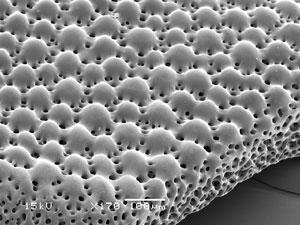Brilliant brittlestars:
Entire skeleton forms one big compound eye
This is the pre-publication version which was subsequently revised to appear in Creation 30(3):54–55.

The brittlestar or serpent star is similar to a starfish, but has five waving arms attached to a disc. Although it doesn’t seem to have any eyes, it has a puzzling ability to flee from predators and catch prey. And it even changes colour from dark brown in daytime to grey at night.
Dr Joanna Aizenberg, an expert in material science, especially biological mineral structures, at Lucent Technologies’ Bell Laboratories, led a team that solved this mystery.1
According to one report, its ‘entire skeleton forms a big eye … brittlestars were one big compound eye’.2
They found that the brittlestar species Ophiocoma wendtii secretes tiny crystals of calcite (calcium carbonate, CaCO3 ) which formed ‘spherical microstructures that have a characteristic double-lens design’, and ‘form nearly perfect microlenses’. The array of microlenses focuses light a small distance into the tissues (4–7 μm) where nerve bundles detect the light. Brittlestar species that were indifferent to light lacked these lenses.
The abstract of their paper states:
‘The lens array is designed to minimize spherical aberration and birefringence and to detect light from a particular direction. The optical performance is further optimized by phototropic chromatophores that regulate the dose of illumination reaching the receptors. These structures represent an example of a multifunctional biomaterial that fulfills both mechanical and optical functions.’
Dr Aizenberg used much easier-to-understand language when explaining to reporters the nuts-and-bolts significance of what the team’s findings actually mean. For example, she said that the visual system of lenses in the brittlestar is far superior to any manufactured lenses.
‘This study shows how great materials can be formed by nature, far beyond current technology,’ said Dr Aizenberg. She went on to point out: ‘In general, arrays of microlenses are something that technology tried a couple of years ago. Nobody knew something like that already existed in nature.’
Commenting on the brittlestar discovery in the same issue of Nature, Roy Sambles, of the University of Exeter’s Dept of Physics, explained that:
- There has to be ‘exquisite control’ of the calcite growth to form the lens structures
- The calcite must grow as single crystals with the optical axis parallel to the axis of the double lens (to avoid birefringence effects)
- ‘each microlens should ideally have minimal optical aberration, and that seems to be the case.’3
And how did such intricate and efficiently coordinated microlenses come to exist ‘in nature’? Aizenberg’s colleague and co-author of the study, Gordon Hendler, made his views clear to the dogmatically pro-evolution National Geographic:
‘Thanks to evolution, they [brittlestars] have beautifully designed crystal lenses that are an integral part of their calcite skeleton. Those lenses appear to be acting in concert with chromatophores and photoreceptor tissues.’4

Huh? ‘Thanks to evolution’ these creatures have ‘beautifully designed’ microlenses acting ‘in concert’ with other (incredibly specialised) parts of the body? This evolutionary ‘explanation’ is totally vacuous—where is even a proposed sequence of small changes guided by natural selection at every step, let alone one demonstrated in the fossil record?
Surely such evidence of design is evidence for a Designer. And on the basis of what has been made, we can see that the Designer is evidently ‘streets ahead’ of anything that humans have so far come up with—as the evolutionists themselves concede, using the brittlestar as an example:
‘Once again we find that nature foreshadowed our technical developments.’
Of course, it was the Designer—the God of the Bible—through his handiwork in ‘nature’ (not ‘nature’ itself) that ‘foreshadowed our technical developments.’ But surely the Scriptures aptly describe those who deny a Creator:
- You turn things upside down, as if the potter were thought to be like the clay! Shall what is formed say to him who formed it, ‘He did not make me’? Can the pot say of the potter, ‘He knows nothing’? (Isaiah 29:16)
- … Does your work say, ‘He has no hands’? (Isaiah 45:9)
References
- Aizenberg, J., Tkachenko, A., Weiner, S., Addadi, L. and Hendler, G., Calcitic microlenses as part of the photoreceptor system in brittlestars, Nature 412(6849):819–822, 2001. Return to Text.
- Abraham, J., Eyeless Creature Turns Out to Be All Eyes, Access Research Network, 12 September 2001. Return to Text.
- Sambles, R., Armed for light sensing, Nature 412(6849):783, 23 August 2001 (commentary on Ref. 1). Return to Text.
- Roach, J., Brittle Star found covered with optically advanced eyes, National Geographic News, 22 August 2001. Return to Text.

Readers’ comments
Comments are automatically closed 14 days after publication.